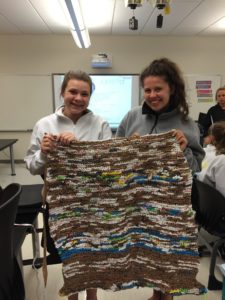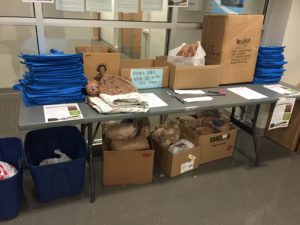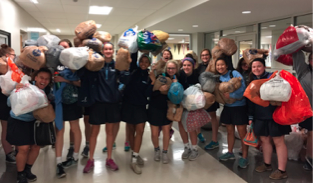2017, Cinncinnati, Ohio, USA
Tori Lyon and Veronica France developed a project called Turning Trash into Treasure, focused on improving their watershed (the Mill Creek) by reducing the amount of plastic bags that end up as litter. The project consisted of two parts, phase one and phase two. They began their project by educating their school community through daily announcements informing classmates on the importance of keeping their local watershed clean and the detrimental effects of plastic bags on  the environment. After kick-staring the education portion of their project, they started working on implementing phase one.
the environment. After kick-staring the education portion of their project, they started working on implementing phase one.
Phase one of the project consisted of collecting plastic bags from their school community and distributing reusable cloth bags to the students. Tori and Veronica set up a station in a busy hallway of the school where students could turn in their plastic bags. For every 25 plastic bags a student turned in, they received a custom made, reusable cloth bag. Inside each cloth bag was an informational flyer containing more facts about the Mill Creek watershed and the detrimental effects of plastic bags as litter. In order to keep track of how many bags were brought in, each student who donated plastic bags filled out a slip with their name, grade and number of bags brought in. This provided Tori and Veronica with an easy way to account for the bags donated. After they held a week-long bag collection event and distribution at school, they transitioned into phase two of the project in which they created sleeping mats out of the collected plastic bags.
 Phase two started with a bag prepping party at which everyone folded, cut, and looped the plastic bags into balls of “yarn”. This ball of plastic yarn was then crocheted into sleeping mats that were donated to the homeless. They conducted significant amounts of research on how to properly crochet plastic sleeping mats, as well as the benefits of sleeping mats for those who are homeless. The mat weaving process was very time consuming and involved intricate work, so the students sought out the help of their school community for completing this part of our project.
Phase two started with a bag prepping party at which everyone folded, cut, and looped the plastic bags into balls of “yarn”. This ball of plastic yarn was then crocheted into sleeping mats that were donated to the homeless. They conducted significant amounts of research on how to properly crochet plastic sleeping mats, as well as the benefits of sleeping mats for those who are homeless. The mat weaving process was very time consuming and involved intricate work, so the students sought out the help of their school community for completing this part of our project.
They had an overwhelming response to their project! Tori and Veronica were hoping to collect about 2,000 plastic bags, but received over 17,000 plastic bags. Since this was such a great number of bags, they are planning on donating the extra bags to Matthew 25 Ministries where groups of volunteers work to complete similar projects. They will continue to make mats until the end of the year.
Their project reached a large scope, and they were able to help improve the condition of our watershed.
